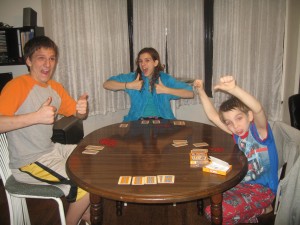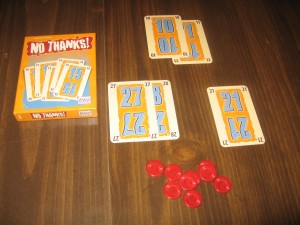Welcome back to the unofficially dubbed “board game week” here on my blog, though this particular game isn’t so much of a board game as it is a card game. With the last card game I introduced (For Sale) being given the proverbial thumbs down, I was skeptical about bringing this one out so soon. It didn’t turn out to be too bad after all.
No Thanks has a deck of numbered cards (3-35) and chips. That’s it. The object of the game is to have the least amount of points in your pile when the game ends.
So how does it work?
A certain amount of cards are removed from the shuffled deck and are placed out of the game. Each player is then given so many red chips, which serve as both a negative one point for end game scoring and for being able to pass on a card.
One player is chosen to start the game and draws a card from the deck.
This player can either:
1) Accept the card, placing it in front of them.
2) Pass, placing a red chip near the card.
If that player passes, the next player (clockwise) has the choice of taking the card and the red chip, or places their own red chip into the mix. Players continue passing until a player finally accepts the card, adding the chips that have accumulated on said card to their pile. Passing may happen frequently, especially if a large number card is drawn…which obviously no one would want.
Once a player has taken a card, the next player (clockwise) draws a new card and the above process repeats.
There is a twist however…if you manage to get two or more numbers that form a straight, you only count the lowest number in that straight to your final score. For example, if a player has a 12 card and accepts a 13 card, they’d still only score 12 points rather than 25. In the process, this hypothetical player may have gotten some free red chips out of the deal which he or she could later use for passing or end game scoring.
There is a bit of math involved, but I approve as it helps to keep the minds of the young ones sharp. It’s refreshing to watch my son compare the card on the table with the red chips that are currently played on it to see if it would be a good deal. The older ones sometimes bite the bullet and take the larger card in the hopes they can form a straight later on. This would reduce their points significantly while saving up their red chips…which in turn reduces their score in the end by one per chip.
This game requires a little bit of strategy and luck. I mention luck because cards are removed prior to play, which means you never know if a particular card exists in the deck that might help you complete your straight.

I asked them to give me a thumbs up or a thumbs down to express their thoughts on the game. Make of this picture what you will.
Overall, the game was fun, albeit short. It would serve well as a filler in between longer board games or if you were traveling with family / friends. It’s also good for squeezing in a quick fifteen minute game before bedtime, as others in my collection can take well over two hours to play. I’d recommend it as it is only $10.00, though creative people might be able to get their own stack of chips and create their own variant with a deck of normal playing cards.
Final Verdict: 6/10
—

